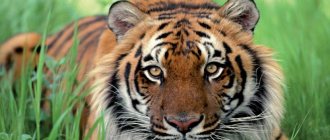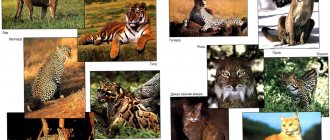- Wild animals
- >>
- Mammals
The liger is the largest representative of the cat family. These amazing cats were bred by crossing two different species, so they exist exclusively in zoos. Ligers are distinguished by their unique character traits, which they adopted from both parents.
Origin of the species and description
Photo: Liger
A liger is a representative of the cat family, namely a hybrid of a male lion and a female tigress. For a long time, scientists did not suspect that these two species could interbreed, although they belong to the same genus of panthers. Also, a lioness and a male tiger can also produce a hybrid - tigon or tiger lion, which is significantly different from its brother. The liger took a confident position as the largest representative of the felines - before that, the Amur tiger took its place.
Evolutionarily, the genus of panthers has many uncertainties, which is why scientists for a long time could not determine which large cats belong to the genus and, moreover, did not suspect that they could interbreed with each other. It is generally accepted that the progenitor of the panther genus is the extinct cat Panther Scowby, which is also the progenitor of pumas.
Video: Liger
Because of this, pumas were also classified as panthers for a long time. The divergence of cats supposedly occurred about six million years ago, but is still controversial among geneticists. Ligers are unique representatives of the genus. Thanks to their appearance, scientists have resumed research into the DNA of big cats, not excluding the possibility of other interspecies crossings.
Researchers believe that snow leopards and jaguars are also prone to interbreeding, but the arguments remain theoretical due to numerous genetic risks. The appearance of the liger prompted zoology to further study big cats.
Appearance and features
Photo: What a liger looks like
The liger is a very large animal. It can weigh more than 400 kg, and the standard height at the withers is about 100 cm. Stretching out to its full length, a liger can occupy the entire 4 meters. The width of the mouth of such a predator stretches up to 50 cm. In general, the animal, at first glance, resembles a lion with a sparse mane.
Interesting fact: The largest liger is Hercules. Its height at the withers is 124 cm, and its weight is more than 418 kg.
The male liger's genes are responsible for development, and the more genes the lion passes on to its offspring, the larger and more massive it will be. The tigress's chromosomes are weaker than those of the lion, which is why the liger's dimensions exceed the standards of big cats. Male ligers have thin or no manes, but their heads are very massive - they are 40 percent larger than the heads of male lions and almost twice as large as the heads of Bengal tigers. In general, the dimensions of a liger are almost twice the size of an adult lion.
The color of ligers is cream and light red. The belly, inside of the paws, neck and lower jaw are white. The coat is thick, soft, with a dense undercoat. Faded brown stripes are located throughout the body. Ligers can be lighter or darker, including white ligers - descendants of a white tigress and a white lion. All ligers have very large paws and a sagging back with a pronounced pelvis.
The belly of ligers is hanging and looks excessively large. Male ligers sometimes have thick reddish sideburns instead of a mane. From the tigress they also got white spots on their ears, which serve a camouflage function.
Hydrides of Leopards and Tigers
They are sometimes called Dogla, an informal Indian name used for the supposedly natural hybrid offspring of an aberrantly patterned male Leopard and a Tigress. The correct scientific term for such a hybrid is Leoger.
In India, there are unconfirmed reports of offspring resulting from crossing a Leopard with a Tigress, i.e. Indian folklore claims that large male Leopards sometimes mate with Tigresses in their natural habitat. The supposed Dogla was first discovered in the early 1900s. Many reports probably still refer to large Leopards with stripes on their bellies. One story said: “After examining it, I discovered that it was a very old male hybrid. Its head and tail were purely those of a panther (Indian Leopard) but with the body, shoulders and neck of a Tiger. The design was a combination of rosettes and stripes, the latter being black, wide and long, although somewhat blurred and tending to break into rosettes. The head was spotted. Stripes prevailed over rosettes.” The skin of this hybrid, if it ever existed, has been lost. Supposedly it was larger than the Leopard and, although male, exhibited some feminization of features as would be expected in a sterile male hybrid.
K. Sankhala's book "Tiger" describes large individuals, which the author calls "bastards", apparently, hybrids of a Leopard with a Tigress are proposed (the reverse specimen is unlikely to arise in the wild, since a wild male Tiger would probably kill a female Leopard rather than be with be friends with her). Sankhala noted that there is a belief among the local population that Leopards and Tigers naturally hybridize.
The book Tiger, Symbol of Freedom, edited by Nicholas Courtney, states: “Rare reports have been made of Tigresses mating with Leopards in the wild. There was even a story that rosettes were seen on the predators, the Tiger's stripes being the most visible on the body. The animal was a male measuring just over 2.44 meters in length.”
The 1951 book Mammalian Hybrids reported that the individuals born from Tiger-Leopard matings were sterile.
Tigard is the hybrid offspring of a Tiger and a female Leopard (Leopardess). The only known mating attempts between the two species have produced stillborn young. In 1900, Carl Hagenbeck crossed a female Leopard with a Bengal Tiger. The stillborn offspring had spots, rosettes and stripes. Henry Sherren wrote: “A male Tiger from Penang was friends with two female Indian Leopards, and twice the relationship ended in success.” The leopardess gave up her cubs prematurely; the embryos were in the first stage of development and were hardly larger in size than newborn mice. There is no mention of a second Leopardess."
There are no surviving photographs of hybrids of Leopards and Tigers.
Where does the liger live?
Photo: Novosibirsk liger
In the wild, lions and tigers do not have overlapping habitats. Because of this, they do not have offspring - previously, when these two species could have adjacent territories, they also avoided each other due to a fundamentally different way of life: lions are gregarious, and tigers are solitary.
However, there are still references to ligers. In 1798, scientists found written monuments that mentioned the offspring of a tigress and a lion, which appeared in animals living in cages in India. In 1837, a liger cub was presented to Queen Victoria as a gesture of goodwill - evidence that tigers and lions had interbred under artificial conditions.
The liger is an artificially bred animal. Lions and tigers get along well with each other in zoos, and this only reinforces interbreeding. Scientists are debating whether ligers can live in the wild.
They agree that the most suitable areas for ligers to live are the following areas:
- India;
- central USA;
- South America.
Ligers are also often compared to saber-toothed tigers, so it is assumed that in the wild these animals would live in small groups, choosing caves and other enclosed areas. Not long ago, a liger and cubs lived in the Novosibirsk Zoo, but due to genetic diseases, the individuals did not live long.
Lifestyle and habitat
The appearance of ligers in the habitat of tigers and lions is not possible. Lions are animals of the savannas of the African continent. At the same time, tigers, for the most part, live in the Asian part of the world, namely in India, the Far East and the countries of Southeast Asia.
There is not a single officially registered fact of the birth of ligers in natural conditions. All known individuals, and there are about twenty-five of them in the world, were born as a result of interbreeding conditions deliberately created by man.
If lion and tiger cubs of different sexes are kept in the same room since childhood (for example, in a zoo cage), unique offspring may appear, and then in about 1-2 cases out of a hundred. At the same time, the liger cat spends its entire life in conditions of lack of freedom under human control (in cages in zoos, enclosures in national parks).
Scientists suggest that in ancient times, when the living conditions of lions and tigers were the same, these animals were not such a unique phenomenon. This, of course, is only a hypothesis, since today there are no convincing facts confirming the birth and life of ligers in the wild.
Researchers have not reached a consensus on whether huge cats can survive in natural conditions. Theoretically, a predator of such a large size, capable of reaching a maximum speed of about 90 km/h while pursuing prey, should be able to feed itself.
However, its enormous size can cause a cat with such a body mass to not be able to get food for itself, as it will quickly get tired, catching up and tracking down prey. In their behavioral characteristics, ligers resemble both parents. Tigers are not very sociable and prefer loneliness. Ligers are most often very sociable.
Males clearly love increased attention to their person, which makes them look like lions and, in most cases, have a peaceful nature (possibly due to an insufficient amount of testosterone in their body). The female ligress often becomes depressed if she finds herself alone, perhaps remembering the pride, where her ancestors were not at all bored.
Ligers, of course, are not domestic animals; they, like their parents, remain predators with instincts and habits passed on to them genetically. It should be noted that extraordinary animals lend themselves well to training, and they can often be seen in circus performances.
What does a liger eat?
Photo: Liger cat
The liger eats a lot of meat, so the costs of keeping it in zoos are enormous. To maintain the genetic potential of a predator, ligers are regularly introduced to live prey so that the cats can hunt and learn the nuances of wild life. In general, a liger eats from 10 to 15 kg of meat, depending on its gender, age and size.
The following “dishes” are most often served to ligers:
- chickens, including live ones, which ligers kill on their own;
- rabbits, also sometimes live;
- processed beef meat, offal, heads and hooves with hard bones for ligers to wear down their teeth;
- eggs, in particular - white, crushed with shell;
- fat milk.
Ligers do not refuse raw fish and play with it with pleasure. Also, large cats are often offered watermelons: they play with them and, in the end, bite them. Plant food is included in the daily diet of ligers. They are given all kinds of vitamin mixtures to keep the big cats healthy. Such mixtures are especially important for babies, who need to strengthen the skeleton and prevent possible diseases.
Interesting fact: Ligers have never lived in the wild, so they initially do not accept live prey as food. They start eating it only when they look at the example of lions and tigers.
There is always a lot of fresh growing grass in the liger's enclosure. Big cats often lie among tall grass and bite it - this indicates the need for vitamins in the body of a big cat. They are offered peaches, apricots, tomatoes, cucumbers, lettuce and many other fruits and vegetables as natural vitamins.
Mr. Cat recommends: a list of Panther hybrids
Below are two tables showing the many possible variations of Panthera hybrids. They, as a rule, are named by the “portmanteau” method, that is, a combination, a linguistic combination of the names of the parents. The name is obtained depending on which species is the father (this syllable will be the first) and which is the mother. For example, the cub of a Lion and a Tigress is called a Liger, because the Lion is a male parent, and the Tigress is a female.
First generation hybrid table
| Species from the genus Panthera | Tigress | Lioness | Jaguares | Leopardess |
| Tiger | Tigers Tigress | Tigon Tigonessa | Tiguar Tiguaressa | Tigard Tigardess |
| a lion | Ligress' liger | Leo Lioness | Liguar Liguaressa | Lipard Lipardessa |
| Jaguar | Jagger Jagressa | Jaglion Jaglionia | Jaguar Jaguares | JaguarpardJaguapardess _ |
| Leopard | Leoger Leogressa | Leopon Leoponessa | Leguar Leguaressa | Leopard Leopardess |
Leopons Tiguar
Female hybrids are fertile in the first generation. When crossed with males of different Panther species, they produce crosses of the second, third and subsequent generations.
Table of hybrids of the second, third and fourth generations
| Species from the genus Panthera | Tigonessa | Ligressa | Jaguarpardess | Leguaressa | Liguaressa |
| Tiger | Titigon Tigonessa | Tiliger Tiligress | Tijagupard Tijugapardessa | Tileguar Tileguaressa | Tiliguar Tiliguaressa |
| a lion | Litigon Litigonessa | Lilygress's Lilyger | Lidjugupard Lidjupardessa | Lileguar Lilleguaressa | Liliguard Liliguardessa |
| Jaguar | Yagtigon Yagtigonessa | Yagliger Yagligressa | Yaguagupardus Yaguagupardessa | Jagleguar Jagleguaressa | Yagliguar Yagliguaressa |
| Leopard | Leotigon Leotigonessa | Leoligress Leoligress | Leojaguapard Leojagupardessa | Leoleguar Leoleguaressa | Leoliguar Leoliguaressa |
| Leopon | Leoptigon | Leopliger | Leopard | Leopleguar | Leopliguar |
| Liger | Liton | Liger | Yagliger | Lilleguar | Liliguar |
| Jagger | Jagitonger | Jagiligr | Japanpadder | Jaleguar | Jaliguar |
Titigon
Litigon
Features of character and lifestyle
Photo: Hybrid liger
The character of ligers can be called versatile. These cats have inherited behavioral traits from both their lion father and tiger mother. From lions, ligers adopted a love for social groups. Lions have a very positive attitude towards all big cats. They easily get along with each other and fit into prides of lions. In relation to other cats, ligers are non-confrontational, love affection, and strive to be close to other relatives.
On the other hand, ligers have adopted from tigers the tendency to mark territory and defend it. The liger has a flock, which he perceives as family, but he also has his own corner, which belongs only to him. Female ligers are especially prone to this, just like tigresses do. Also, from tigers, ligers inherited a love of water and swimming. They willingly frolic in ponds, drag prey there, dive and simply lie in the water - lions have a dislike for water and even fear of bodies of water.
Fun fact: Male ligers have very low testosterone levels, which makes them the least aggressive. But female ligers are prone to depression.
The liger is also similar to the tiger in that it can easily withstand low temperatures. Tigers are adapted to cold weather - their fur is known for its dense undercoat, which the tigress passed on to their children - the ligers. At the same time, ligers do not suffer from heat, since their fur provides competent thermoregulation. In severe frosts, ligers happily roll around in the snow, and in hot weather they lie in the water.
Nutrition
The food of this animal resembles the food of its parents. Of course, a liger will not accompany a herd of antelope for hours to attack, but it also prefers meat. Workers at zoos and circuses where ligers are kept closely monitor the diet of their charges.
In addition to meat and fish, ligers receive plant foods, vitamins and mineral supplements. It takes a lot of money to feed such cats, however, any zoo would consider it an honor to have such beauties.
Social structure and reproduction
Photo: Liger cubs
Male ligers are absolutely sterile, but females have a chance of having offspring, although it is very low. This does not negate the fact that female ligers have a period of estrus, during which they show increased attention to males of all species: ligers, tigers and lions. A ligress can only have offspring from lions. In search of a partner, a female liger is even able to climb over the high fence that separates her from the enclosure with other large cats. Regardless of whether she ends up with a tiger or a lion, the female’s behavior will be the same.
A ligress in heat marks her territory, letting the males know that she is ready to mate. In zoo conditions, keepers do not allow any exhibition tournaments between male tigers or lions, so the female, as a rule, does not choose a partner for herself - he is simply released into her enclosure. Big cats have very beautiful foreplay. They affectionately rub their heads against each other, lie next to each other for a long time and lick each other's fur. For lions, such foreplay is faster, but for tigers it can last more than a day. After mating, the female and male separate.
Pregnancy lasts about 110 days. As a result, the female gives birth to one or two cubs, and most often these are the same infertile males. The descendants of a lion and a ligress are called liligers, and this is an extremely rare case when the offspring are born alive and healthy. As a rule, cubs do not survive until three months. In theory, female liligers could have offspring with lions, but lions have a strong genetic potential, which is why the resulting offspring will not resemble ligers - they will be ordinary lion cubs. Often, female ligers do not have milk, which is why zookeepers feed their offspring.
Hybrids of Jaguar and Leopard
Jaguarpard, Yagulep or Yaglop is a hybrid of a Jaguar and a Leopardess. The Chicago Zoo obtained such a female with a rosette. Jaguar-female Leopard hybrids bred at Hellbrun Zoo (Salzburg) have also been described as Jaguarpards, following the usual portmanteau naming convention. Leojaguapard (Leguar or lepjag) is a hybrid of a male Leopard and a female Jaguar. Interestingly, these terms are often used interchangeably, regardless of which animal was the father.
A. D. Bartlett stated: “I have more than once seen cases of a male Jaguar (Panthera onca) breeding with a female Leopard (Panthera pardus). These hybrids were also grown in Wombell's well-known traveling collection.
In the menagerie of Barnabos (Spain), a female Jaguar gave birth to two cubs from a union with a black Leopard, one resembled Doglu, but was somewhat darker, the other was charcoal with rosettes. Since melanism in the Panther (Leopard) is recessive, the Jaguar either had to be black, or was itself a hybrid of the Jaguar with the coal Leopard, carrying the recessive gene.
Female Jaguleps are fertile, and when they mate with Leos, the offspring are called Lijaguleps or lijaguleps. One such complex hybrid was introduced in the early 1900s as the “Congo spotted lion,” an exotic African animal rather than a man-made hybrid.
Natural enemies of the liger
Photo: What a liger looks like
Ligers are the largest cats, but they do not live in their natural habitat. In theory, if ligers settled in any territory, they would quickly rise to the top of the food chain, and they would have no natural enemies. Ligers have a number of diseases (in addition to infertility in males) that can cause serious complications for a normal life.
Ligers are prone to mental disorders. The fact is that tigers and lions have different sign systems of communication. Because of this, ligers sometimes experience problems, as a result of which they cannot understand each other or their relatives. For example, tigers and lions have different warning signal systems, so ligers may see the peaceful calls of other cats as a threat.
This situation can even be observed in the relationship between a ligress and her cubs - she may not understand their sign system, inherited from the lion father, which is why she abandons the children and they are raised by zookeepers. Ligres are prone to depression due to incompatible lifestyles. They are both socially inclined and need privacy. Because of this, ligresses even become depressed. Male ligers do not exhibit this behavior - they love to be the center of attention.
Due to their weight, ligers experience enormous pressure on their paws and spine, which can lead to diseases of the bones and joints. It is also impossible to establish the life expectancy of ligers - they live up to 24 years, but scientists are sure that the animals die due to diseases, and not due to natural death.
Interesting Facts
The first reports of unusual animals date back to the end of the 18th century. The image of the mighty beast appeared in the scientific work of the French scientist Etienne Geoffroy Saint-Hilaire. The animals received their own name at the very beginning of the 20th century, and it comes from the initial letters of two words of foreign origin - lion and tiger.
Ligers occupy the 2nd place on the planet in size among predators; elephant seals are considered the largest. However, among land predators, giant cats are the largest. Lig cubs are born weighing half a kilogram, and by 2 months. cubs reach 7 kg, while a tiger cub at this time weighs only 4 kg.
In Bloemfontein Park (South Africa) there lived a heavy liger. He weighed about 800 kg. The weight of the liger , which now lives in Miami, and is distinguished by the largest dimensions among all existing ones, is 410 kg. They are struck by the size of the claws of an adult individual, the length of which is more than 5 cm.
The liger lives today only next to humans. The information obtained about these giant cats makes it possible to improve the conditions in which they live, choose a balanced diet, and increase their life expectancy. Of course, amazing animals cause delight and surprise to everyone who has seen them, even in photographs.
The liger, whose size is simply amazing, in turn, has a rather gentle character, but its incredible dimensions and strength make this animal very dangerous for the person nearby.











